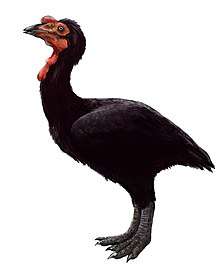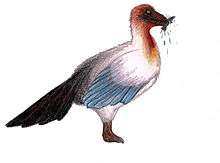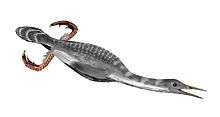Oculudentavis
Oculudentavis is an extinct genus of saurian of uncertain taxonomic placement, originally identified as an avialan dinosaur (bird, in the broad sense). It contains a single known species, Oculudentavis khaungraae. The only known fossil of Oculudentavis comprises a complete skull preserved in Burmese amber. The skull was 1.4 centimetres (0.55 in) in length, indicating that Oculudentavis would have been comparable in size to the modern bee hummingbird if it were an avialan. The amber specimen was retrieved from 99-million-year-old deposits of the Hukawng Basin in Kachin State, northern Myanmar. The specimen is embroiled in controversy regarding its identity and the ethical issues surrounding the acquisition and study of Burmese amber.
| Oculudentavis | |
|---|---|
| Scientific classification | |
| Kingdom: | Animalia |
| Phylum: | Chordata |
| Class: | Reptilia |
| Clade: | Sauria |
| Genus: | †Oculudentavis Xing et al., 2020 |
| Type species | |
| Oculudentavis khaungraae Xing et al., 2020 | |
Discovery and naming
Oculudentavis is known from a complete skull preserved in Burmese amber, found at the Angbamo site in Tanai Township, Kachin State, northern Myanmar. The genus name Oculudentavis was chosen to include the combination of the words oculus, dentes, and avis. These Latin words translate to "eye", "teeth", and "bird" respectively. The specific name honors Khaung Ra, the woman who donated the piece of amber to the Hupoge Amber Museum for study. Presently, the holotype is cataloged as HPG-15-3 in the Hupoge Amber Museum.[1]
Description
The skull of Oculudentavis was 1.4 centimetres (0.55 in) in length, indicating that Oculudentavis would be the smallest known Mesozoic dinosaur, if such an identification is correct. The animal would have been comparable in size to the modern bee hummingbird, the smallest known living dinosaur.[1]
It had a slender snout and a bulbous skull roof, as well as a long tooth row of twenty-three teeth. The orbits were very large and had a thick sclerotic ring formed from unusual spoon-shaped sclerotic ossicles. This indicates that it was likely a diurnal animal, active mostly during the day. The eyes bulge sideways according to an outwardly slanted jugal (cheekbone), indicating that it did not possess binocular vision. It may have had a relatively strong bite and a specialized diet of small invertebrates, based on its sharp teeth, extensively textured mouth skin, tall coronoid process, and robust, inflexible skull.[1]
Oculudentavis had a collection of plesiomorphic ("primitive") and advanced traits compared to other Mesozoic avialans. For example, it retains separate frontal, parietal, postorbital, and squamosal bones, which are fused together or lost in modern birds. The extensive tooth row is also similar to non-avialan theropods. On the other hand, it lacks a separate antorbital fenestra and the bones of the snout are elongated and fused. These features are more common among modern birds. Some traits, such as the acrodont or pleurodont tooth implantation and spoon-shaped sclerotic bones are unprecedented for dinosaurs as a whole, and instead, are common among modern lizards.[1] A patch of seemingly scaly skin occurs near the base of the skull, unusual for a bird, but consistent with a lepidosaur identity. The high tooth count and apparent lack of an antorbital fenestra or quadratojugal bone have also been used to argue against an avialan identity.[2]
Classification
Specializations caused by the small size of Oculudentavis lead to difficulties in making precise conclusions on its classification. A phylogenetic analysis in the original description supports a basal placement for Oculudentavis within Avialae, only slightly closer to modern birds than Archaeopteryx. This suggests that a ~50 million year ghost lineage exists between the Late Jurassic and the middle of the Cretaceous. A small amount of most parsimonious trees instead suggest that it is an enantiornithean, like other birds preserved in Burmese amber.[1]
Soon after the publication of the article, a number of paleontologists have voiced skepticism on whether Oculudentavis is even a dinosaur, due to a much higher number of similarities with squamates than with theropods. The general skull shape is considered the largest argument in favor of bird affinities, but some living lizards (Meroles, Anolis) and extinct reptiles (Avicranium, Teraterpeton) are known to have convergently evolved a bird-like skull shape. The usage of a bird-focused phylogenetic analysis (without considering lizards) also has been criticized. The editors of the Institute of Vertebrate Paleontology and Paleoanthropology's Fanpu publication have published an editorial arguing for an interpretation of Oculudentavis as a lizard rather than an avialan.[2]
Paleoecology

Burmese amber is retrieved from the Hukawng Valley, the geographical representation of the Hukawng Basin, a large Mesozoic-Cenozoic sedimentary basin in Kachin State of northern Myanmar. The strata have undergone folding and faulting. The basin is considered to be a part of the West Burma Block or Burma Terrane, which has a debated tectonic history. The block was part of Gondwana during at least the Early Paleozoic, but the timing of rifting is very uncertain, with estimates ranging from the Devonian to Early Cretaceous. It also is disputed whether the block had accreted onto the Asian continental margin by the time of the amber deposition.[3]
Some members of the flora and fauna have Gondwanan affinities[4] although albanerpetonids are more typically found in the northern continents.[5] A recent paleomagnetic reconstruction finds that the Burma Terrane formed an island land mass in the Tethys Ocean during the Mid Creaceous at a latitude around 5-10 degrees south of the equator.[6]
The amber deposits have provided a wealth of fossil flora (including mosses and bamboo-like monocots),[7] arthropods (among many others pisaurid spiders, onycophorans, dyspnoid harvestmen, and coccoid scale insects),[7] and a number of vertebrates (including well-preserved three-dimensional anatomy of skeletons and feathers),[7] that the paleoecology of the earliest Cenomanian environment has been interpreted in detail. The existence of the frog Electrorana limoae (the oldest record of frogs in amber),[7] the snake Xiaophis myanmarensi, lizard Cretaceogekko burmae,[8] a albanerpetonid[5] and several enantiornitheans including Elektorornis and undescribed specimens,[9] suggest a humid, warm, tropical forest ecosystem that contained at least some freshwater habitats. The presence of ammonites and marine ostracods suggest that some of the amber-bearing forests existed near the shore of a marine environment.[7]
Zircons in the tuffs of the formation in which the Burmese amber has been found have been U-Pb dated to 98.8 ± 0.6 Ma, or the Cenomanian epoch of the earliest Late Cretaceous.[7][10]
Controversy
Ethics of Burmese amber
Upon the high-profile release of the paper, which was featured on the front cover of Nature, several palaeontologists renewed discussion around controversies related to Burmese amber, which were first raised in 2019. These include poor working conditions for miners (many of whom are underage), and allegations that the high-end trade of Burmese amber helps to fund the Kachin conflict, akin to blood diamonds.[11][12][13]
Scientific criticism
In response to the paper's taxonomic identification of Oculudentavis, critics such as Wang et al. also have noted a deliberate use of ambiguous language by the authors — in particular, the statement that Oculudentavis is "bird-like" as opposed to being a bird, and the admission that "there is a strong potential for new data to markedly alter [their] systematic conclusion". The decision of the authors to assume that Oculudentavis is a bird a priori, without testing other possible positions, for their morphological description and phylogenetic analysis also was called "illogical" by Wang et al., who noted that the rejection of this hypothesis would compromise the paper's conclusions and significance.[2]
References
- Xing et al., 2020
- Wang et al., 2020
- Metcalfe, 2017
- Poinar, 2018
- Matsumoto et al., 2018
- Westerweel et al., 2019
- Xing et al., 2018
- Arnold & Poinar, 2008
- Angbamo, Kachín, Myanmar in the Paleobiology Database
- Shi et al., 2012, p.162
- Gammon, 2020
- Witton, 2020
- Joel, 2020
Bibliography
- Oculudentavis
- Xing, L.; O'Connor, J. K.; Schmitz, L.; Chiappe, L. M.; McKellar, R. C.; Yi, Q.; Li, G. (2020). "Hummingbird-sized dinosaur from the Cretaceous period of Myanmar". Nature. 579 (7798): 245–249. doi:10.1038/s41586-020-2068-4. PMID 32161388.
- Wang, W.; Zhiheng, L.; Hu, Y.; Wang, M.; Hongyu, Y.; Lu, J. (2020). "The "smallest dinosaur in history" in amber may be the largest mix-up in history" (in Chinese). Institute of Vertebrate Paleontology and Paleoanthropology. Retrieved 2020-03-16. Cite journal requires
|journal=(help) - Witton, Mark (2020). "The ugly truth behind Oculudentavis". MarkWitton.com. Retrieved 2020-03-16.
- Geology and dating
- Shi, G.; Grimaldi, D. A.; Harlow, G. E.; Wang, J.; Wang, J.; Yang, M.; Lei, W.; Li, Q.; Li, X. (2012). "Age constraint on Burmese amber based on U-Pb dating of zircons" (PDF). Cretaceous Research. 469: 155–163. doi:10.1016/j.cretres.2012.03.014. Retrieved 2020-03-16.
- Westerweel, J.; Roperch, P.; Licht, A.; Dupont-Nivet, G.; Win, Z.; Poblete, F.; Ruffet, G.; Swe, H.; Kai Thi, M.; Wa Aung, D. (2019). "Burma Terrane part of the Trans-Tethyan Arc during collision with India according to palaeomagnetic data". Nature Geoscience. 12 (10): 863–868. Bibcode:2019NatGe..12..863W. doi:10.1038/s41561-019-0443-2. PMC 6774779. PMID 31579400.
|access-date=requires|url=(help) - Metcalfe, I. (2017). "Tectonic evolution of Sundaland". Bulletin of the Geological Society of Malaysia. 63: 27–60. doi:10.7186/bgsm63201702.
- Paleoecology
- Xing, L.; Stanley, E. L.; Bai, M.; Blackburn, D. C. (2018). "The earliest direct evidence of frogs in wet tropical forests from Cretaceous Burmese amber". Scientific Reports. 8 (1): Article number 8770. Bibcode:2018NatSR...8.8770X. doi:10.1038/s41598-018-26848-w. PMC 6002357. PMID 29904068.
- Poinar, G. (2018). "Burmese amber: evidence of Gondwanan origin and Cretaceous dispersion". Historical Biology: 1–6. doi:10.1080/08912963.2018.1446531.
- Matsumoto, R.; Evans, S. E. (2018). "The first record of albanerpetontid amphibians (Amphibia: Albanerpetontidae) from East Asia". PLOS One. 13 (1): e0189767. Bibcode:2018PLoSO..1389767M. doi:10.1371/journal.pone.0189767. PMC 5752013. PMID 29298317.
- Arnold, E. N.; Poinar, G. (2008). "A 100 million year old gecko with sophisticated adhesive toe pads, preserved in amber from Myanmar" (PDF). Zootaxa. 1847: 62–68. doi:10.11646/zootaxa.1847.1.5. Retrieved 2020-03-16.
- Kachin conflict
- Joel, L. (2020). "Some Paleontologists Seek Halt to Myanmar Amber Fossil Research". The New York Times. p. 1. Retrieved 2020-03-13.
- Gammon, K. (2019). "The Human Cost of Amber". The Atlantic. Retrieved 2020-03-14.
Further reading
- Bird evolution
- Padian, K.; Chiappe, Luis M. (1998). "The Origin of Birds and Their Flight". Scientific American. 278 (2): 38–47. Bibcode:1998SciAm.278b..38P. doi:10.1038/scientificamerican0298-38. PMID 9472492. Retrieved 2020-03-16.
- Dingus, L.; Rowe, T. (1997). The Mistaken Extinction: Dinosaur Evolution and the Origin of Birds. New York: W. H. Freeman and Company. ISBN 0-7167-2944-X.
- Olson, S.L (1985). "The fossil record of birds". In Farner, D. S.; King, J. R.; Parkes, Kenneth C. (eds.). Avian Biology. 8. New York: Academic Press. pp. 79–238. doi:10.1016/B978-0-12-249408-6.50011-X. ISBN 978-0-12-249408-6.
External links
- Press releases
- Press release about Oculudentavis - Scientific American
- Press release about Oculudentavis - Phys.org
- Press release about Oculudentavis - National Geographic
- Other links
- A Tetrapod Zoology article on Oculudentavis, including some discussion on the controversy
- Oculudentavis on YouTube – Nature Video (3:32; 11 March 2020)

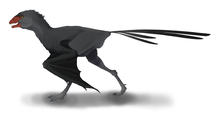
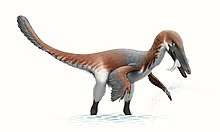
.png)
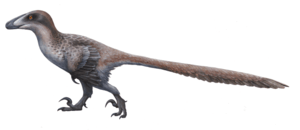

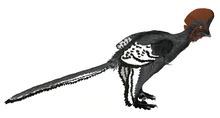
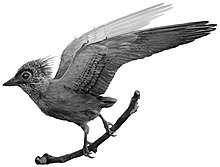

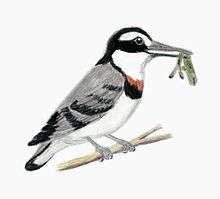
.png)
